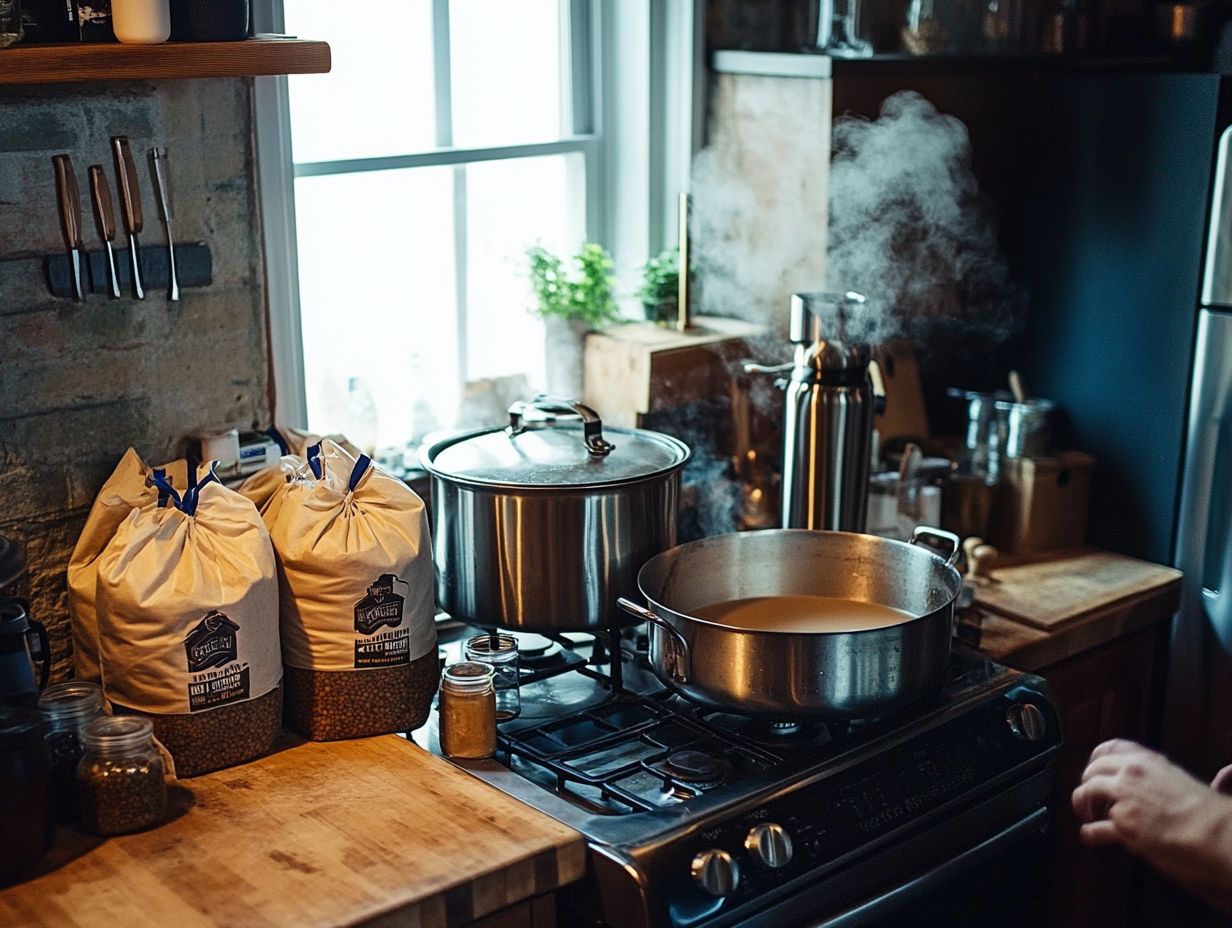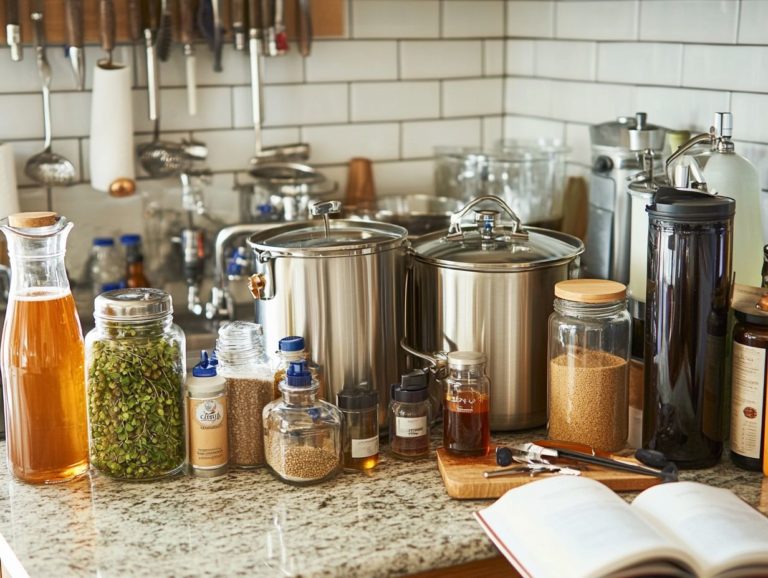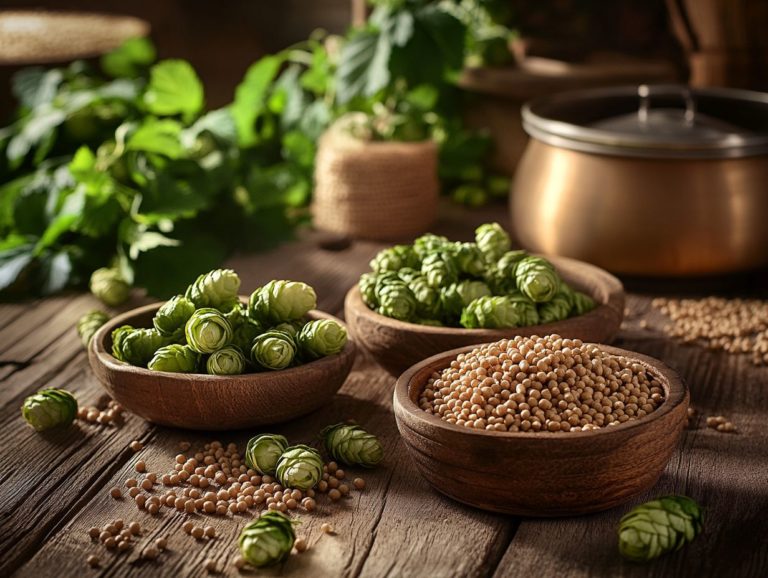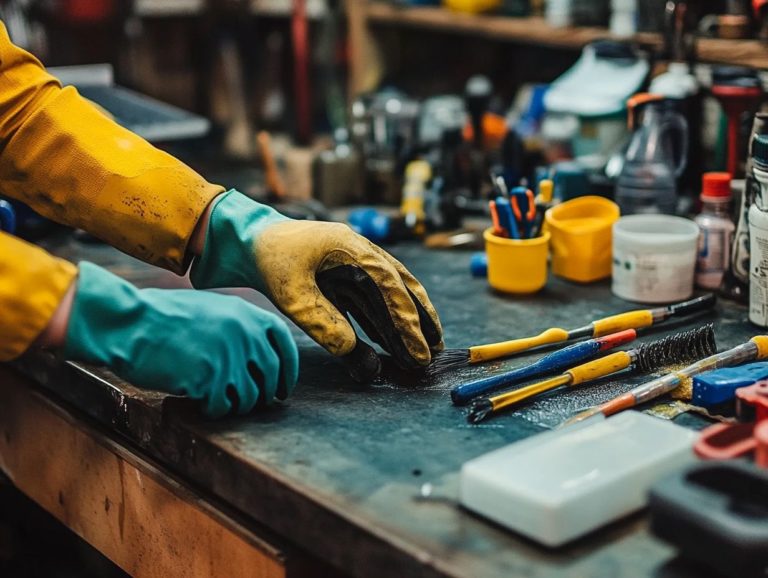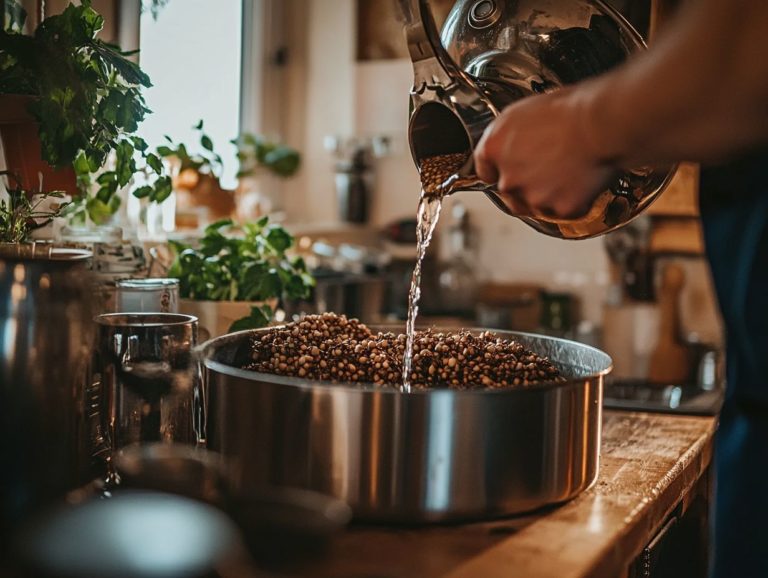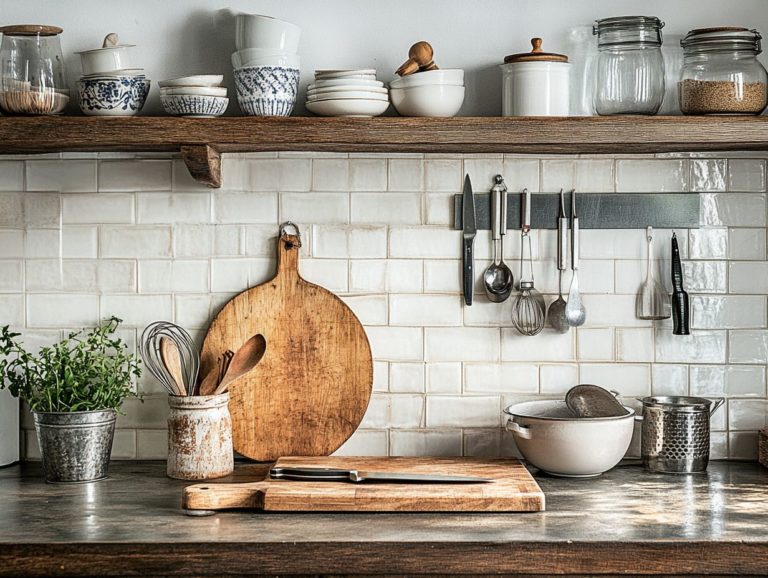How to Brew Beer Without a Kit
Brewing your own beer can be an immensely gratifying endeavor, particularly when you embark on this journey without the crutch of a pre-packaged kit.
This guide will equip you with the essential ingredients, equipment, and steps necessary to craft your own brew from the ground up. From choosing the ideal malt and hops to mastering the fermentation process, it encompasses all the vital information you need.
Moreover, you’ll find invaluable tips designed to enhance your brewing experience, ensuring that it is both enjoyable and successful. Prepare to tap into your inner brewer and create something truly remarkable!
Contents
- Key Takeaways:
- What Are the Basic Ingredients Needed for Beer Brewing?
- What Equipment Do You Need for Beer Brewing?
- What Are the Steps for Brewing Beer Without a Kit?
- 1. Mashing
- 2. Boiling
- 3. Fermentation
- Frequently Asked Questions
- What is the process for brewing beer without a kit?
- Can I use household items to brew beer without a kit?
- Do I need to sanitize my equipment when brewing beer without a kit?
- How long does it take to brew beer without a kit?
- Can I customize the flavor of my beer when brewing without a kit?
- Is it Necessary to Have Experience to Brew Beer Without a Kit?
Key Takeaways:
What Are the Basic Ingredients Needed for Beer Brewing?
As you embark on your homebrewing journey to craft your very own homemade beer, grasping the essential ingredients is crucial to mastering the brewing process. The four primary ingredients malt, hops, yeast, and water each bring their own unique flavors and characteristics to your recipe.
Malt acts as the foundation, providing the sugars necessary for fermentation, while hops introduce bitterness, aroma, and complexity. Yeast is the enchanting organism that fuels fermentation, creating both alcohol and carbonation. Finally, water makes up the majority of your brew, significantly influencing taste and quality.
Together, these components form the backbone of any successful brewing adventure, setting you up for a delightful experience.
1. Malt
Malt is an critical ingredient in the art of beer brewing, providing the essential sugars needed for fermentation while influencing the flavor, color, and body of your final creation.
As you explore the various types of malt, you ll find that each one contributes its own unique characteristics to the brewing process. For example, Dried Malt Extract (DME) is a favored option among brewers, especially those who may not have the time or resources for a full mashing process. This ingredient offers the convenience of extract brewing, all while delivering rich malty flavors and ample fermentable sugars.
On the other hand, Amber DME lends a stunning amber hue and a nuanced caramel flavor, adding depth and complexity to your beer. Your choice of malt not only shapes the sensory profile but also plays a crucial role in the brewing alchemy that ushers you into the delightful and diverse realm of craft beer.
2. Hops
Hops are often hailed as the soul of beer, bringing a delightful bitterness, flavor, and aroma that perfectly balance the sweetness of malt. These aromatic flowers do more than just please the palate; they serve as a natural preservative, enhancing the overall stability of the finished product.
Among the vast array of hop varieties, Saaz hops emerge as a timeless favorite, especially in traditional lagers, thanks to their mild and earthy characteristics. In the brewing process, the timing of your hop additions is key; adding hops early in the boil delivers that essential bitterness, while later additions are crucial for crafting the delicate flavors and aromas that elevate your brew.
This meticulous orchestration of hop usage ultimately shapes your drinking experience, influencing everything from that first invigorating sip to the lingering finish that keeps you coming back for more.
3. Yeast
Yeast is an essential player in the art of beer brewing, serving as the catalyst that transforms sugars from malt into alcohol and carbon dioxide during fermentation.
As you explore the world of brewing, you’ll discover that different yeast types can dramatically shape the character of your final product. Ale yeast and lager yeast are two of the most common, each imparting unique flavors and aromas to your brew. Many homebrewers have embraced dried yeast varieties for their convenience and reliability, making the brewing process smoother and more accessible.
Temperature is crucial in this delicate dance. Higher fermentation temperatures can introduce vibrant fruity esters. Cooler conditions yield a cleaner, more refined profile.
When selecting your yeast, consider the strain and its behavior during fermentation. These elements will affect not only the alcohol content but also the overall complexity and profile of your beer.
4. Water
Water, making up approximately 90% of beer, is undoubtedly the most abundant ingredient, and its quality can dramatically impact the final taste of your brew.
Whether you re enjoying the crispness of a pale lager or the rich depth of a stout, the mineral composition of your brewing water plays a pivotal role in crafting those unique flavors. Factors such as hardness, pH, and specific mineral levels like calcium, magnesium, and sulfates can either enhance or mute various taste profiles. If you aim to elevate your craft, treating your water to achieve the desired mineral balance is essential.
You can easily achieve this with methods like reverse osmosis to remove unwanted impurities or by adding mineral salts to customize the water’s properties. With these techniques, you can ensure that every brew is as flavorful and vibrant as you envisioned.
What Equipment Do You Need for Beer Brewing?
To successfully brew your own beer at home, you must arm yourself with the right brewing equipment, tailored to your chosen methods and techniques. A comprehensive brewing equipment list for beginners typically features a homebrew kit that includes all the essential tools needed to kick off your brewing journey.
Key items in your brewing arsenal should encompass:
- A fermentation vessel for the all-important fermentation process,
- A bottling bucket for transferring and bottling your masterpiece,
- Additional tools like a hydrometer to measure original gravity, ensuring your fermentation and carbonation levels are just right.
Investing in quality brewing equipment is crucial for achieving that exceptional beer taste you crave.
1. Mash Tun
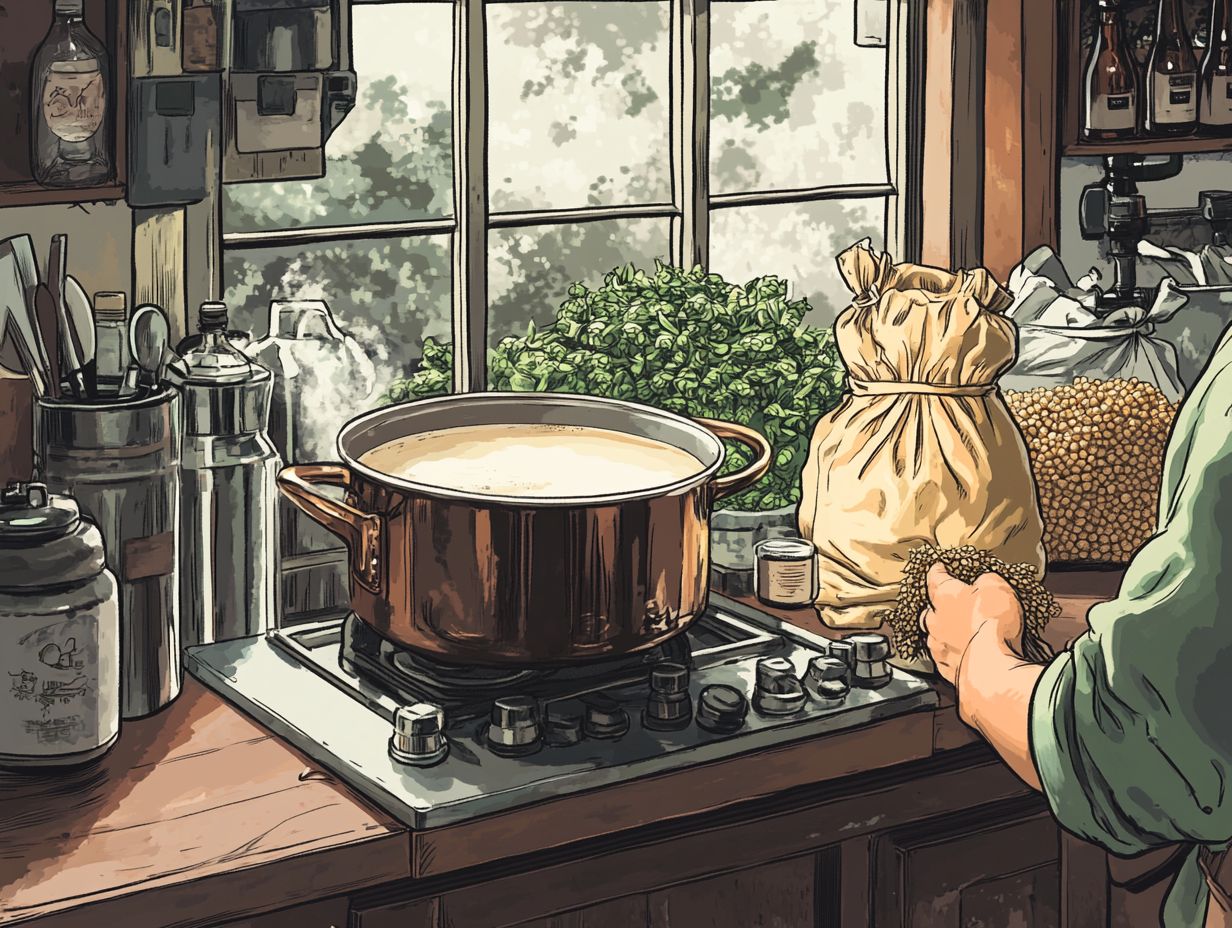
A mash tun is a critical piece of brewing equipment where the magic of mashing takes place, transforming the starches in your malt into fermentable sugars.
This vessel typically features a conical or circular base, designed to enhance mixing and retain heat effectively. The temperature within the mash tun is crucial, as it activates specific chemical reactions that break down those starches into sugars, primarily maltose, the main sugar produced from malted grains.
Traditionally, you ll control the temperature through the careful addition of heated water or by utilizing temperature-regulated jackets. Making precise adjustments is vital for achieving various flavor profiles and maximizing sugar extraction efficiency.
Getting the mash temperature just right dramatically affects the overall quality of your beer. It influences everything from sweetness to body, elevating the mash tun from a mere tool to an essential component in the art of crafting distinctive brews.
2. Boil Kettle
The boil kettle is your stage for transforming wort into a flavorful masterpiece, where hops additions play a critical role in sculpting the beer s aromas and tastes.
This essential step not only sterilizes the wort, ridding it of unwanted microorganisms, but also lays the groundwork for a rich tapestry of flavors. The timing and method of your hops additions during this boiling phase can dramatically shape the final taste profile of your beer. When you add hops early in the process, you boost bitterness, skillfully balancing the sweetness of the malt. Conversely, introducing hops later in the boil enhances those enticing aromas and flavors without overwhelming the brew with bitterness.
By mastering this process, you empower yourself to craft distinctive and complex beers that reflect your creative vision, elevating the craft of brewing into an art form that beautifully marries science and creativity.
3. Fermentation Vessel
A fermentation vessel is where you introduce yeast to the wort, setting in motion the magical transformation that turns that sugary liquid into beer.
These vessels come in a range of designs, including glass carboys, food-grade plastic buckets, and stainless steel fermenters, each with its own distinct advantages. For instance, glass carboys are known for not letting oxygen in, which plays an important role in preserving the quality of your brew.
In contrast, plastic buckets are lightweight and often easier to clean, making them a favorite choice among homebrewers.
Monitoring fermentation conditions is essential for achieving optimal results. Utilizing a thermometer or a temperature controller can help you maintain the ideal range to promote healthy yeast activity. Measuring gravity with a hydrometer (a tool to measure liquid density) allows you to track the fermentation process effectively, ensuring that your brewing experience is both successful and rewarding.
4. Bottling Bucket
A bottling bucket is an essential piece of brewing equipment for transferring your beer from the fermentation vessel and preparing it for conditioning in bottles. This specialized bucket not only makes pouring the beer into bottles a breeze but also plays an important role in maintaining a sanitary environment throughout the brewing process, especially in home brewing.
Cleanliness is absolutely crucial during bottling to safeguard against any unwanted microorganisms that could contaminate your brew and spoil the carefully crafted flavors developed during fermentation. You ll often find that a bottling bucket is equipped with a spigot (a valve for dispensing liquids), allowing for smooth and controlled filling, which helps minimize oxygen exposure and improve beer taste.
By utilizing this equipment, you can ensure an optimal conditioning phase for your beer, allowing it to carbonate and mature properly, which is essential for making beer. Paying attention to these details creates a delicious, one-of-a-kind beer that you will love to share with friends.
What Are the Steps for Brewing Beer Without a Kit?
Brewing beer without a kit can be an incredibly rewarding experience, offering you the freedom to unleash your creativity throughout the process. It involves several essential steps, which are part of the brewing guide:
- mashing
- boiling
- fermentation
- bottling
In the initial mashing step, you’ll combine grains or malt extract with hot water to extract those desired sugars. This mixture is then boiled to sterilize the wort and incorporate hops additions, adding that delightful flavor you crave.
Once the boiling stage is complete, you’ll cool the wort and transfer it to a fermentation vessel, where the magic happens yeast is added, and the fermentation process begins. After fermentation wraps up, it s time to bottle your creation for carbonation, completing your brewing journey and resulting in a unique homemade beer that s entirely your own. You may also consider using a plastic bottle for this phase.
1. Mashing
Mashing is your first step in the art of beer brewing, where crushed malt meets hot water, transforming starches into sugars that yeast can turn into alcohol. This step is fundamental in brewing methods.
This essential stage not only sets the groundwork for your beer’s sweetness and body but also plays a pivotal role in shaping its overall flavor profile. Aim for temperatures between 150 F and 158 F (65 C to 70 C) based on the flavors you want.
By maintaining this temperature for about 60 minutes, the enzymes in the malt get to work, efficiently breaking down those starches into sugars. The specific duration and temperature during mashing can enhance various beer flavors, adding layers of complexity to your final brew.
However, if you rush the mashing process or stray from the optimal temperature, you risk missing out on those desired flavors or ending up with an overly dry finish. Precision is essential in your brewing journey.
2. Boiling
Boiling is a critical step in your beer brewing journey, where you heat the wort not just to sterilize it, but also to introduce hops that will shape its bitterness and flavor.
This vital process not only eradicates undesirable bacteria but also allows you to extract those essential oils from the hops, which play a significant role in defining your beer s aroma and overall character. Timing is key in this stage; if you add hops too early, you risk overwhelming bitterness, whereas late additions can elevate aromatic qualities without stirring up excessive bitterness.
The duration of the boil typically between 60 to 90 minutes also impacts the beer s color and clarity. The intensity of your boil affects evaporation rates, concentrating flavors while minimizing unwanted compounds that could mar the final taste. Boiling water at the right temperature is essential here.
Therefore, honing your boiling technique is essential for achieving the quality you desire in your finished brew.
3. Fermentation
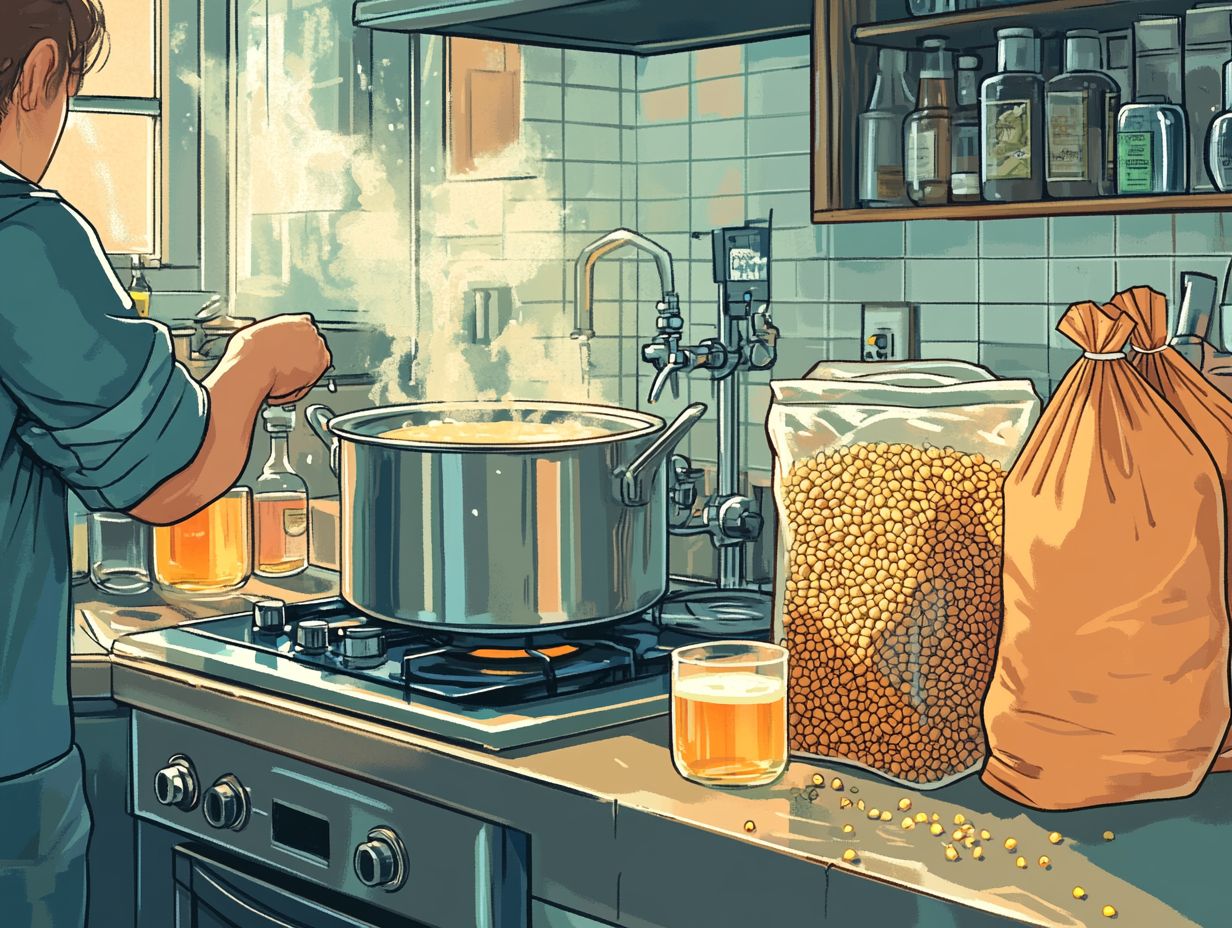
What happens to your beer during fermentation? Fermentation stands as a pivotal phase in brewing, where yeast diligently consumes the sugars present in the wort, transforming them into alcohol and carbon dioxide. This stage is integral to beer conditioning.
This fascinating process transforms basic ingredients into a deliciously rich beer while simultaneously generating essential byproducts like esters and phenols, which are flavor compounds that can give beer fruity or spicy notes, significantly shaping the final taste profile.
Monitor the temperature closely for successful fermentation; most yeasts flourish within a range of 65 F to 75 F, depending on the specific strain you re using. Maintaining a cooler temperature can be beneficial for certain yeast strains. Employing a thermometer or creating a temperature-controlled environment will help you maintain these optimal conditions. Proper brewing equipment is essential for this.
You ll know fermentation is in full swing when you observe bubbling in the airlock, sediment forming at the bottom of your fermentation vessel, and a noticeable increase in aroma. For the best results, regularly check the specific gravity with a hydrometer. Original gravity readings will guide you here. This will enable you to assess fermentation progress and make any necessary adjustments along the way.
Try these techniques and watch your brewing skills flourish!
4. Bottling
Bottling is the final step in the brewing process, where you transfer the carefully crafted beer into bottles for carbonation and conditioning before you get to enjoy it. This crucial phase not only encapsulates all the hard work that has gone into brewing but also dictates the final taste and texture of your beverage. Keeping a brewing equipment list can help you stay organized.
Achieving the proper carbonation levels is essential, as it significantly influences how the beer feels on your palate. Proper bottle conditioning helps in achieving this. You might find that brewers often rely on priming sugars to stimulate carbonation during this stage, ensuring that each sip delivers the desired experience. Using Saaz hops can also add a unique flavor.
The importance of sanitation cannot be overstated. Whether you’re using plastic or glass bottles, thorough cleaning is imperative to prevent contamination that could spoil your product. By maintaining strict hygiene standards, you can ensure both the integrity and quality of your final brew, allowing you to savor every drop with confidence. Utilize proper brewing techniques to achieve the best results.
Want to brew great beer at home? Here are some essential tips!
You can achieve remarkable success in beer brewing without a kit by following a few essential tips that elevate your brewing practices and enhance the quality of your homemade beer. Here are some brewing tips you might find helpful:
First and foremost, it’s crucial to ensure that all your equipment and surfaces are sanitized to prevent contamination and spoilage. This includes using a sanitizer and keeping a warm room for fermentation. Next, using high-quality brewing ingredients, such as fresh malt and hops, will dramatically enhance the flavors and aroma of your brew. Home brewing supplies can be sourced from a reliable homebrew shop.
Stick closely to your beer recipe and measurements for the best consistency. Paying attention to measuring ingredients accurately is key.
Finally, diligently tracking your brewing progress monitoring fermentation temperature and starting gravity will enable you to troubleshoot any potential issues and refine your brewing skills like a true artisan. Using brewing software can assist in this process.
1. Sanitize All Equipment and Surfaces
Sanitation is a critical element of successful beer brewing, playing a crucial role in eradicating unwanted bacteria and wild yeast that could compromise your batch. Whether using plastic or glass bottles, sanitation is key.
Before diving into the brewing process, it s essential for you to meticulously sanitize all your brewing equipment and surfaces. This includes using effective sanitizing solutions like iodine-based products or no-rinse sanitizers. This encompasses everything from fermenters to stir rods, ensuring that no hint of contamination threatens the flavor or quality of your final product. This is a crucial step in your brewing practice.
By employing effective sanitizing solutions, such as iodine-based products or no-rinse sanitizers, you elevate the cleanliness of your workspace to a new standard. This isn’t just a trivial step; it’s your frontline defense against spoilage and undesirable off-flavors. This way, you can focus your energy on crafting the perfect brew while cultivating a healthy fermentation environment.
2. Use Quality Ingredients
Using quality ingredients is essential for a great homebrew! Fresh malt, hops, and yeast play a crucial role in shaping the overall flavor and character of your beer. It s imperative that you prioritize selecting the finest components available to ensure a superior final product.
When sourcing your malt, seek out grains that are freshly milled. Amber DME is a good example of a quality product. Older varieties can lose their essential oils and enzymes, negatively impacting both taste and fermentation efficiency. Similarly, choose your hops with care; look for aromatic varieties that have been stored properly to preserve their vibrant flavors.
A trip to your local homebrew shop not only allows you to inspect these ingredients firsthand but also gives you the chance to consult with knowledgeable staff. They often stock brewing supplies that can enhance your brew, sharing insights on the freshest selections or unique blends that could elevate your beer s profile. Focusing on quality sourcing helps you craft amazing brews!
3. Follow the Recipe and Measurements Carefully
Following a beer recipe and adhering to precise measurements is essential for achieving consistency and success in the brewing process. This ensures that every batch you create is repeatable. A beer recipe kit can be very helpful in this regard.
When you take the time to strictly follow these guidelines, you elevate your brewing experience into something truly enjoyable and satisfying. This is part of your brewing heritage. Every ingredient, from the type of malt to the hops you select, influences the final flavor profile. Even the slightest deviation can result in significant changes in taste.
Utilizing tools like a hydrometer to monitor the starting sugar level not only supports the fermentation process but also gives you the power to make informed adjustments as needed. This level of diligence in the brewing process results in brews that are not just delicious but also serve as a genuine testament to the art of brewing and the broader brewing journey.
4. Keep Track of the Brewing Process
Keeping track of your brewing process is essential. It enables you to monitor fermentation temperature, starting sugar level, beer fermentation, and other critical metrics that can make or break your brew. Use brewing software to streamline this process.
By meticulously documenting each step from the initial preparation of ingredients to the final bottling you gain invaluable insights into your techniques and beer recipe outcomes. It’s crucial to record any variations in brewing ingredients or conditions since these can significantly influence the final product.
You cultivate a rich archive of your brewing history while positioning yourself to identify patterns that lead to improved beer flavors and performance in your future batches. Emphasizing a systematic approach to tracking enhances both consistency and creativity, making each brewing experience not just rewarding but educational as well. Consider incorporating brewing tips and techniques from a reliable brewing guide to further refine your process.
Frequently Asked Questions
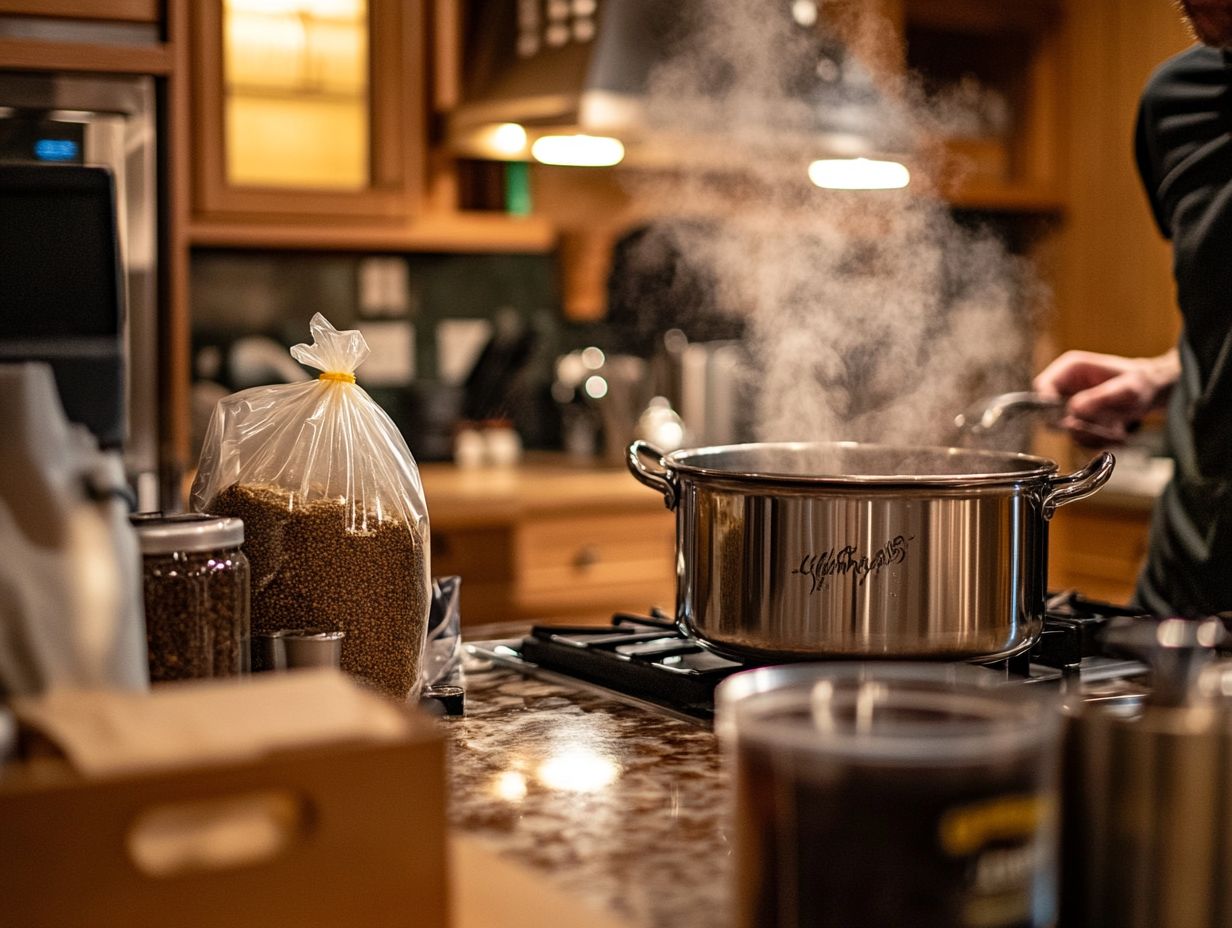
What is the process for brewing beer without a kit?
To brew beer without a kit, gather all the necessary brewing ingredients, such as malt extract, hops, yeast, and water. Then, follow the basic steps of brewing: steeping the grains, boiling the wort, fermenting, and bottling. Utilize a comprehensive brewing equipment list to ensure you have all the needed tools.
Can I use household items to brew beer without a kit?
Yes, you can use household items such as pots, utensils, and plastic soda bottles. However, it is recommended to invest in a few essential brewing tools, such as a hydrometer and a thermometer, for better accuracy and control. Also, consider visiting a homebrew shop for specialized home brewing supplies.
Do I need to sanitize my equipment when brewing beer without a kit?
Yes, sanitizing your brewing equipment is crucial when brewing beer without a kit. Any bacteria or contaminants can ruin the taste and quality of your beer. Use a food-grade sanitizer or a bleach solution to sterilize your equipment before and after use. Maintaining good sanitation practices is vital throughout the brewing process.
How long does it take to brew beer without a kit?
The brewing process can take anywhere from 2 to 4 weeks, depending on the type of beer and the fermentation time. Additional steps such as bottling and carbonation can add a few more days to the process. Ensuring a warm room for fermentation and a cooler temperature for conditioning can affect the timing and quality of your homemade beer.
Can I customize the flavor of my beer when brewing without a kit?
Yes, brewing beer without a kit allows for more creativity and customization. You can experiment with different types of hops, grains, and yeast to create unique and personalized flavors for your beer. Measuring hops and other ingredients precisely can help you achieve the desired taste.
Ready to start brewing? Gather your ingredients and enjoy the process!
Is it Necessary to Have Experience to Brew Beer Without a Kit?
Getting Started with Home Brewing
No, you don’t need a lot of experience to brew beer without a kit. Beginners can successfully brew beer by doing some research and carefully following steps.
Don’t be discouraged if your first batch isn’t perfect. Remember, practice makes perfect! Using a brewing guide and connecting with experienced brewers can greatly enhance your skills.

